This classic lasagna recipe combines four layers of homemade lasagna sheets with a hearty meat sauce and lots of melty cheese. Just like Grandma used to make, it’s impressive in appearance yet simple to prepare.
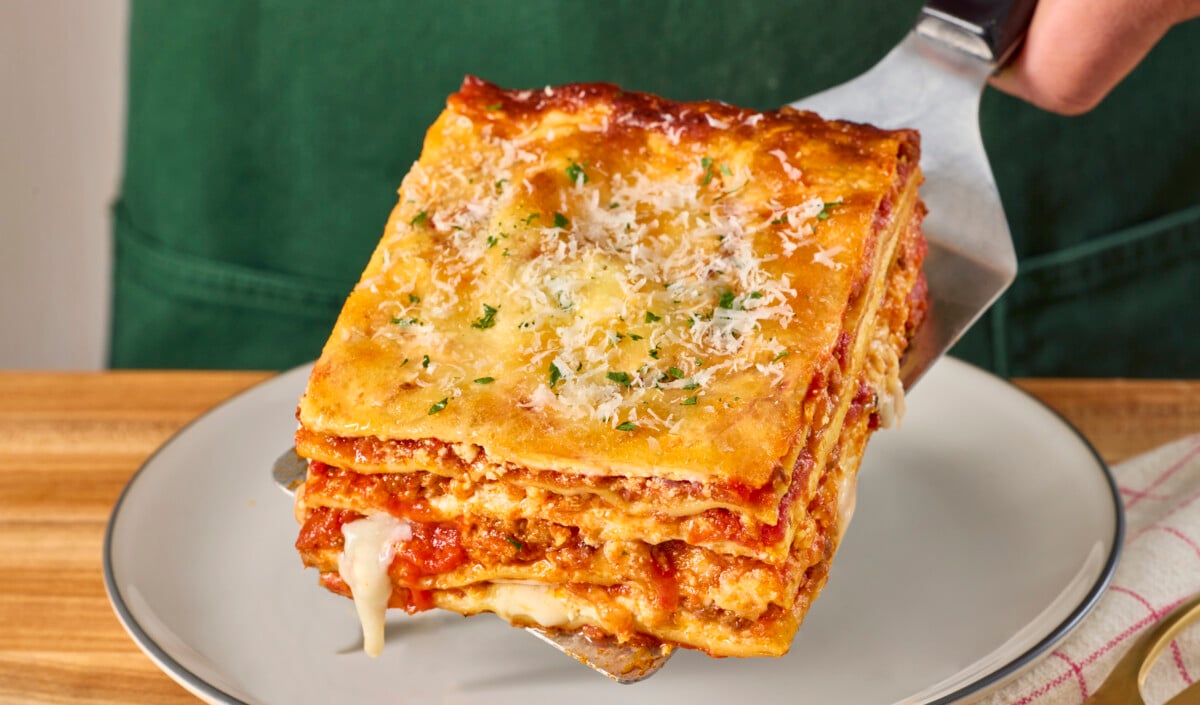
I believe everyone should make homemade lasagna at least once in their life, and I guarantee that this traditional lasagna recipe will be the best you ever taste. Although it’s not completely necessary, I prefer to make my own pasta sheets and will walk you through the steps in case you want to do the same. I promise, it’s easier than it sounds!
Personally, I think it makes for a better melt-in-your-mouth texture, but store-bought lasagna sheets will also work. Even if you follow my recipe partially, everyone in your house will think you can cook!
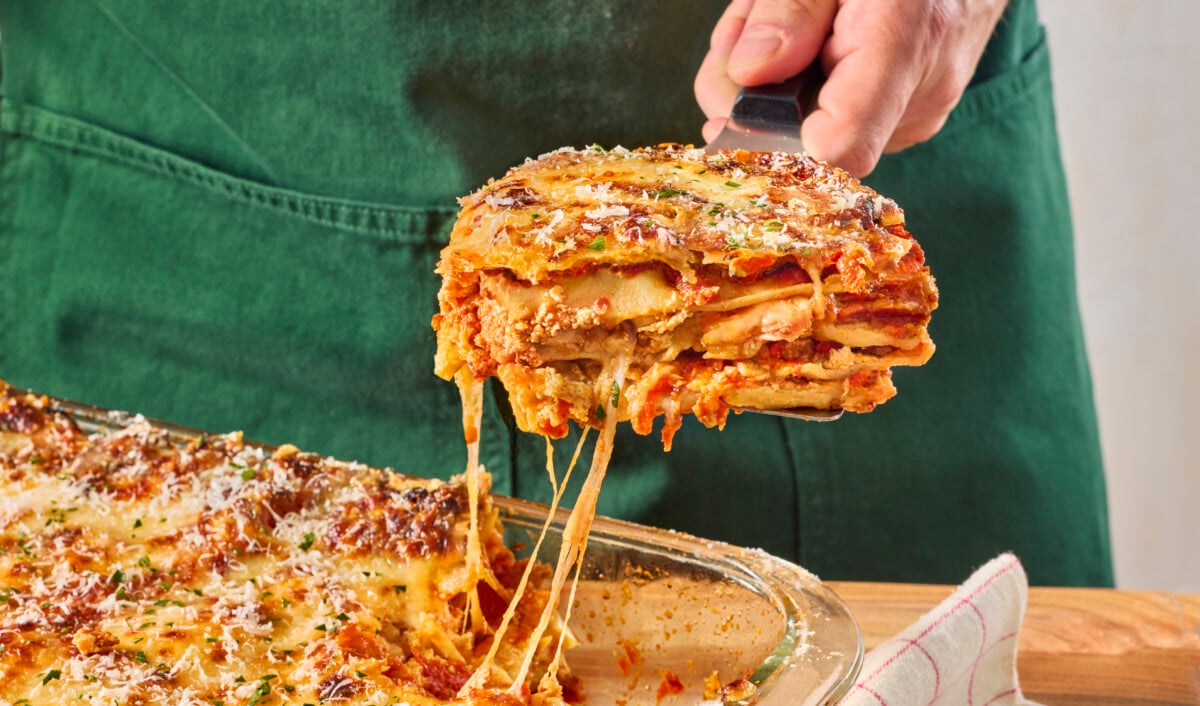
Ingredients and Notes
See the recipe card below for the complete ingredients list and instructions.
Fresh Pasta
- Flour – For the best results, I always recommend using 00 flour. The double zero means that it is finely ground, which allows us to create smooth, pliable dough.
- Eggs – We’re using both whole eggs and egg yolks to give the dough structure while creating a richer flavor. Let them come to room temperature before you begin!
Red Sauce
- Sausage – Some people like to use ground beef, but I much prefer sausage. I use both hot Italian sausage and sweet Italian sausage. Make sure to remove the casings before you begin.
- Garlic and Onion – These add a sweet, savory, pungent taste.
- Spices – Fennel seeds, crushed red pepper flakes, salt, and pepper add a sweet, spicy flavor that enhances the sausage.
- Tomato Paste and Whole Peeled Tomatoes – I use an entire tube of tomato paste along with whole tomatoes for an acidic, umami flavor.
- Fresh Basil Leaves – The bright, sweet flavor complements the acidity of the tomatoes nicely.
Ricotta Filling
- Ricotta – I always use whole milk ricotta. Low-fat ricotta will be runnier and doesn’t have as rich a taste. Cottage cheese can also work in a pinch, but your lasagna won’t be authentic.
- Garlic – Many people like to use plain ricotta, but I infuse mine with more garlicky flavor, microplaning it right into the mixture.
- Eggs – These create a classic lasagna recipe, helping the layers hold together once baked.
- Parmesan – Use a block of Parmesan, and grate it yourself!
- Spices – I always use a good amount of salt and black pepper, and often include nutmeg for extra depth, too.
Assembly
- Cheese – Use extra whole milk ricotta and freshly grated mozzarella to create the decadent, gooey consistency we want. I always grate my mozzarella the long way to create long strands that melt beautifully.
How to Make a Classic Lasagna Recipe
I always start by preparing the pasta, but you can skip that step if not making it from scratch.
1. Prepare Fresh Lasagna Noodles
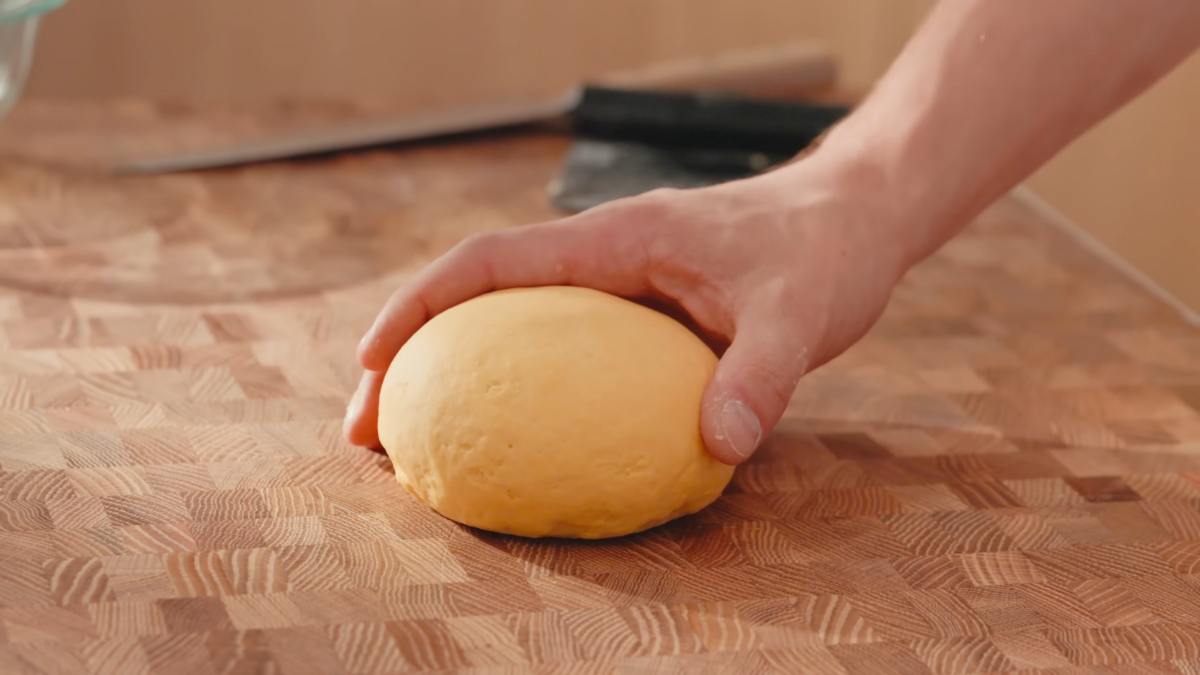
2. Rest. Wrap the dough ball tightly with plastic wrap, and let it rest at room temperature for at least an hour.
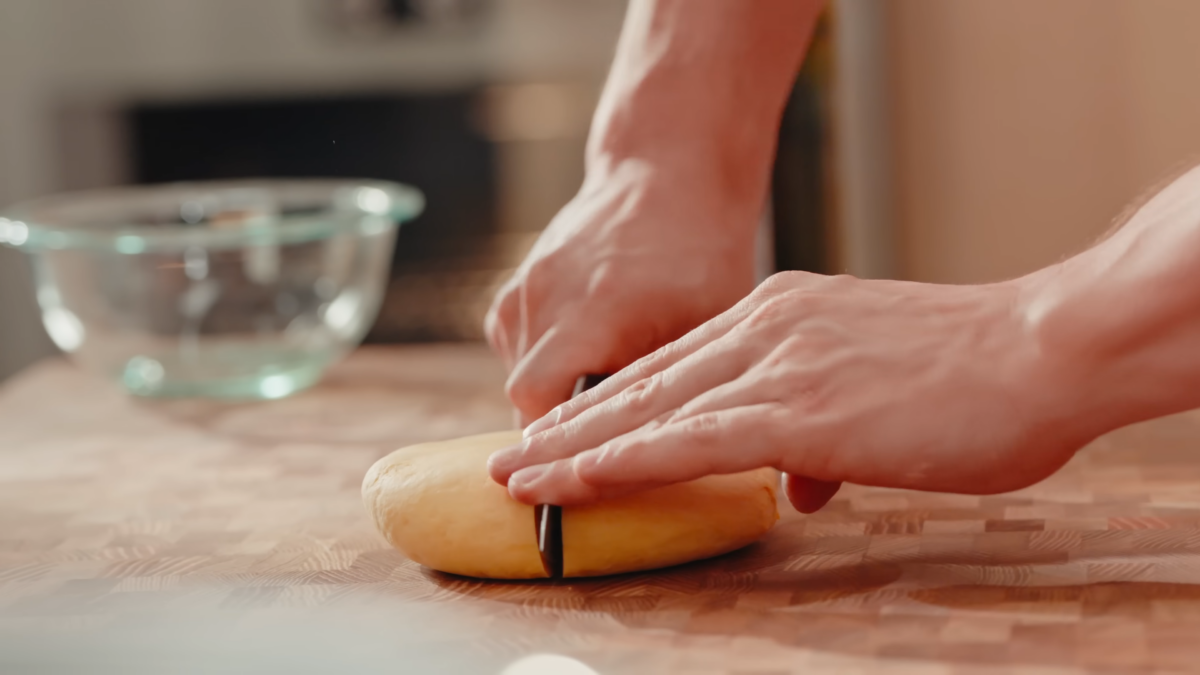
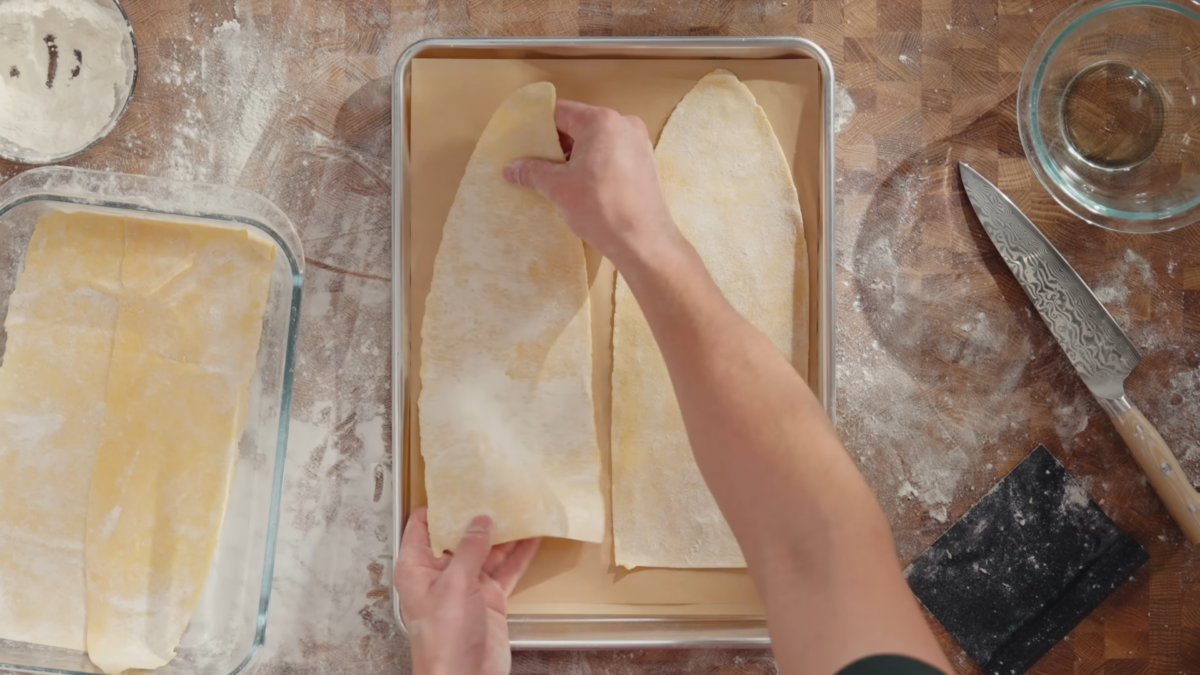
5. Rest. Cover the sheet tray tightly with plastic wrap, and set it aside.
2. Make the Red Sauce
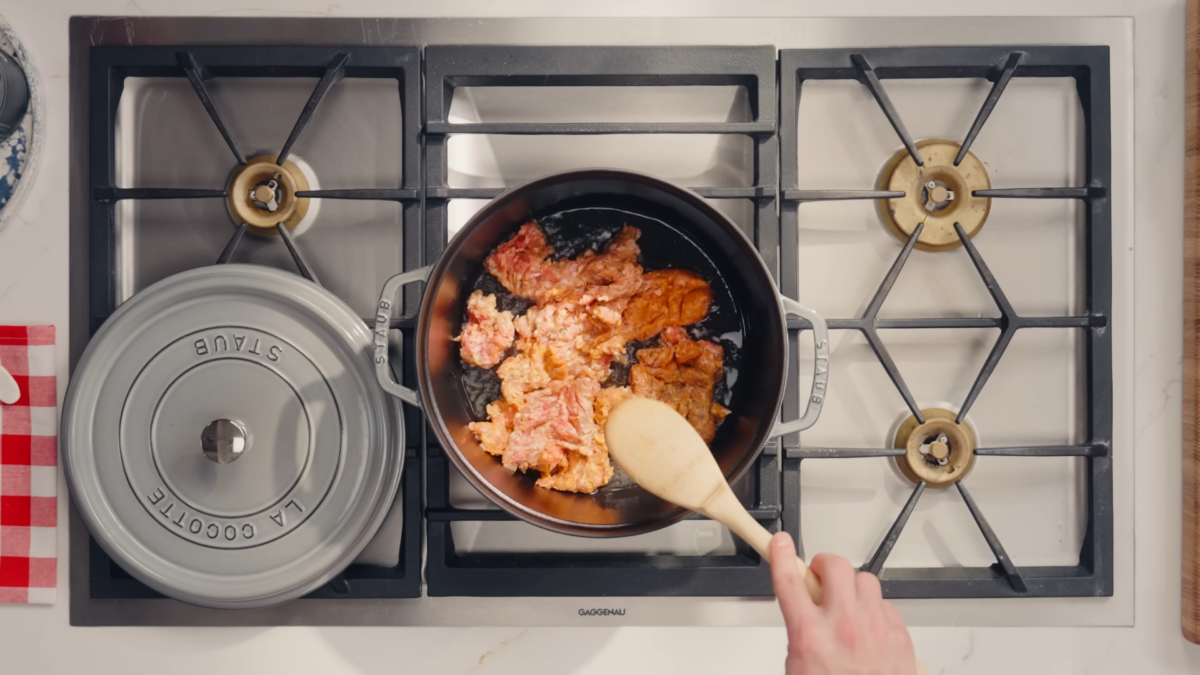
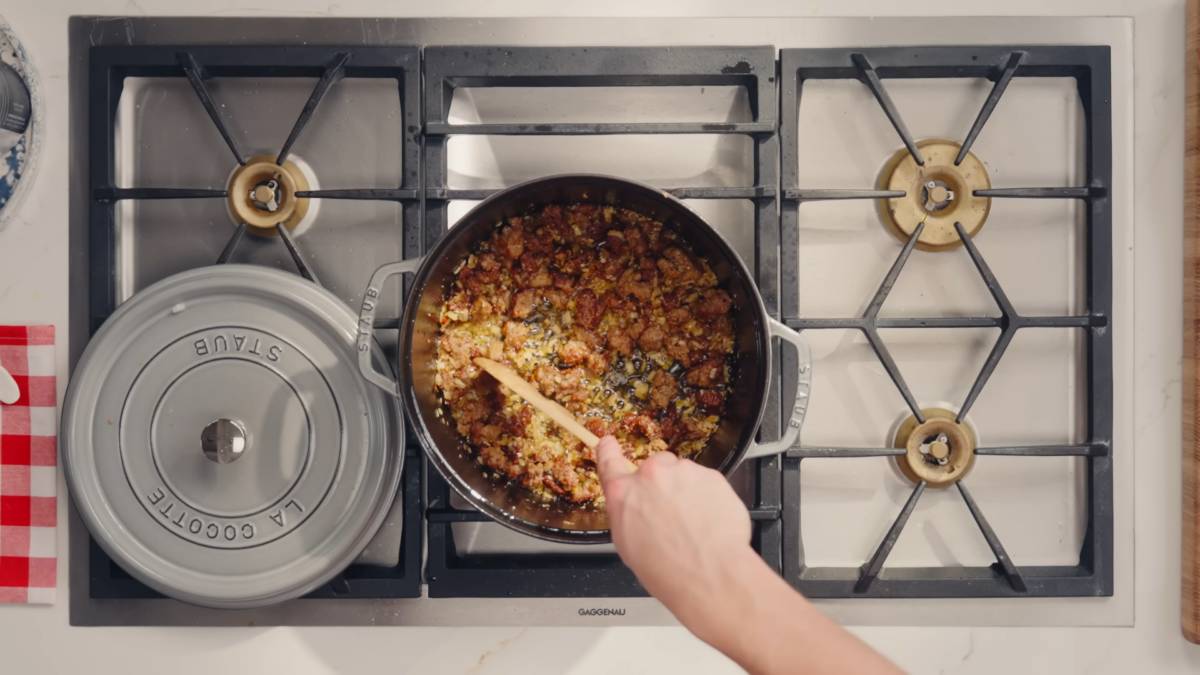
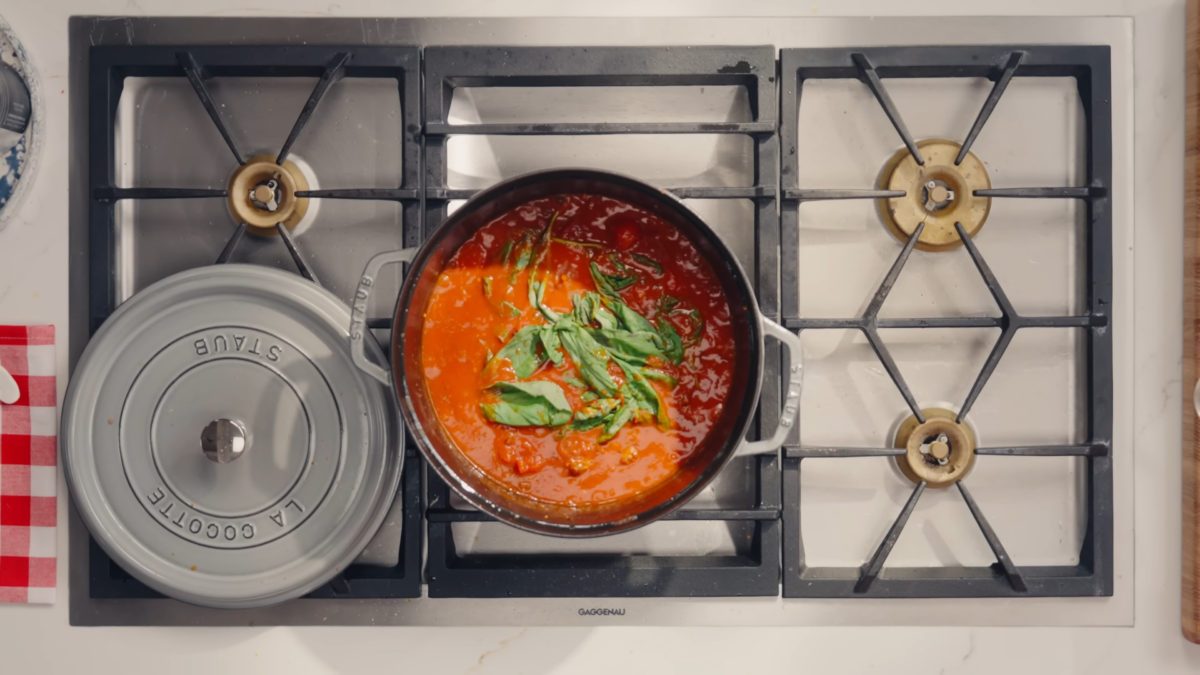
9. Simmer. Bring the sauce to a simmer, and cook uncovered, stirring occasionally. Season with additional salt, pepper, or sugar, if needed. Once the sauce reduces by about 25%, remove it from the heat and cover to keep warm.
3. Prep the Ricotta Filling
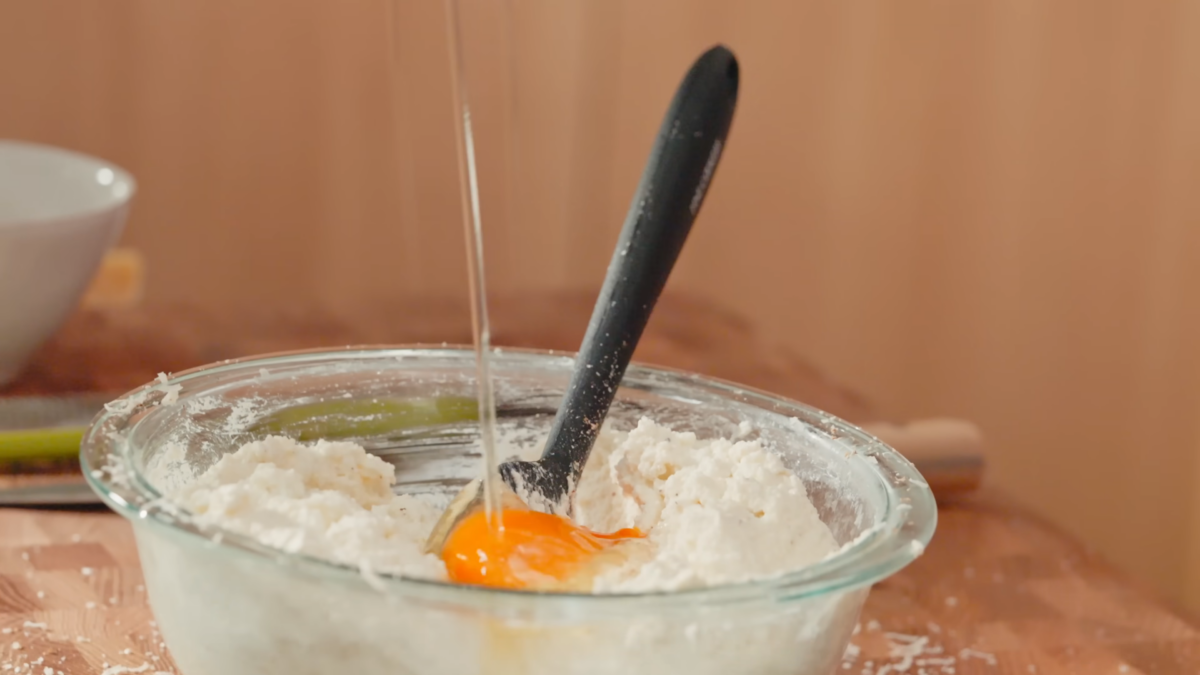
11. Chill. Cover and chill in the fridge, removing it one hour before you begin assembling. This makes it easier to spread!
4. Assemble
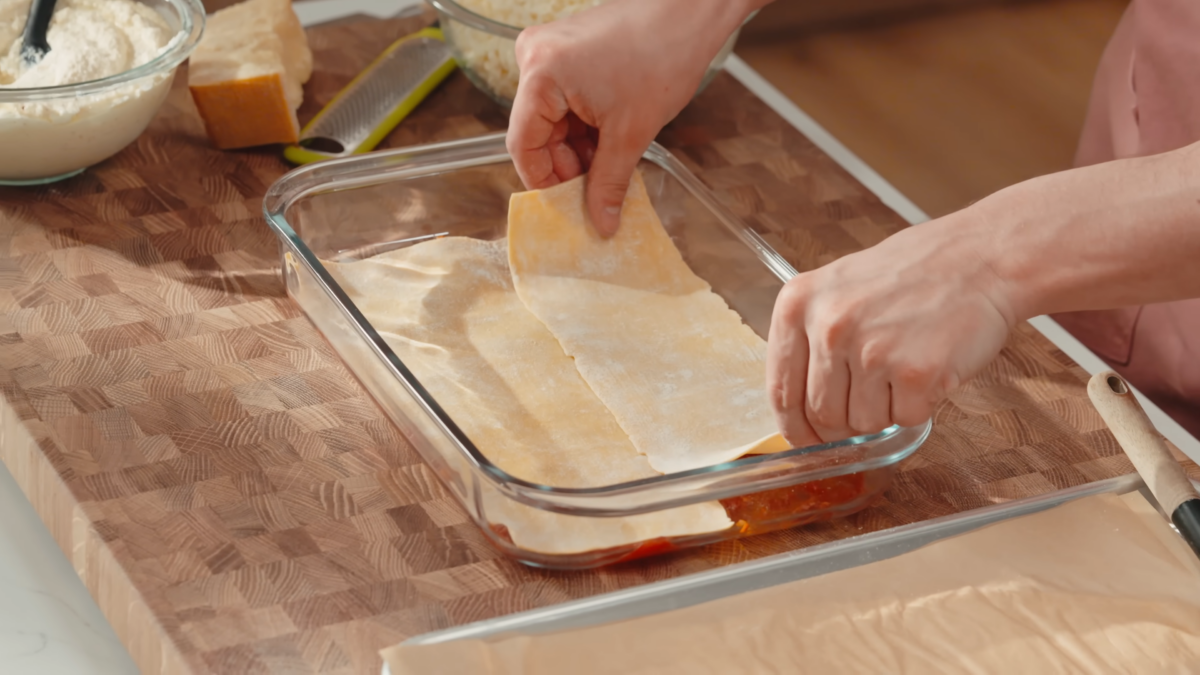
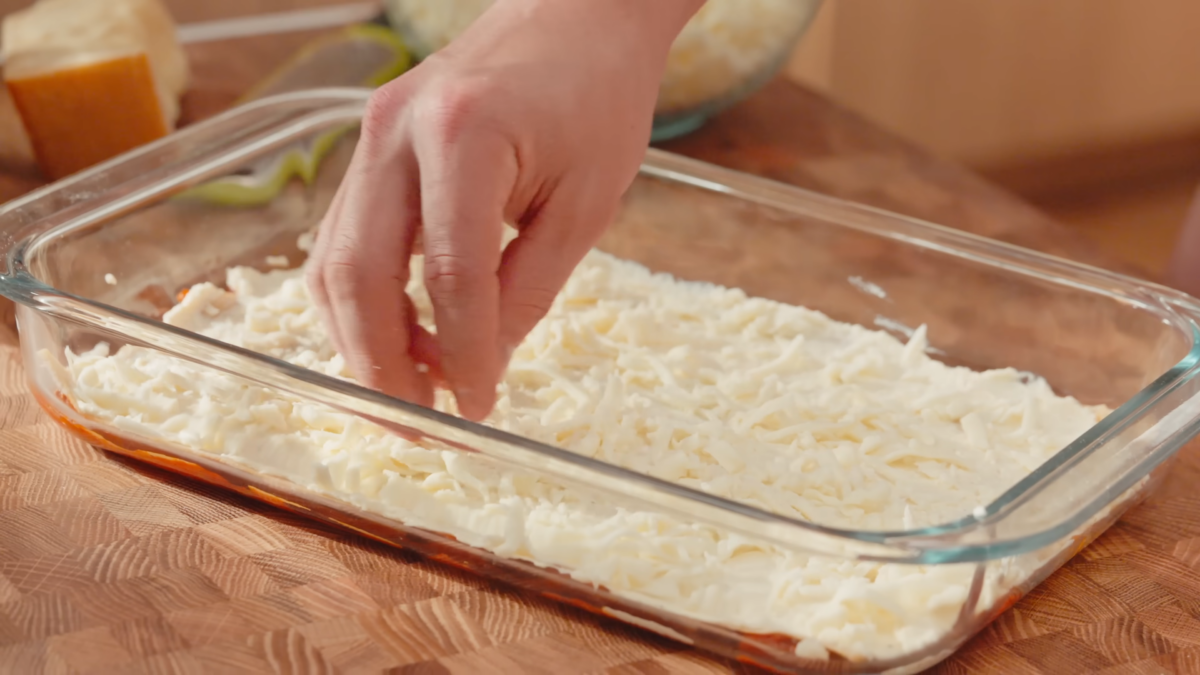
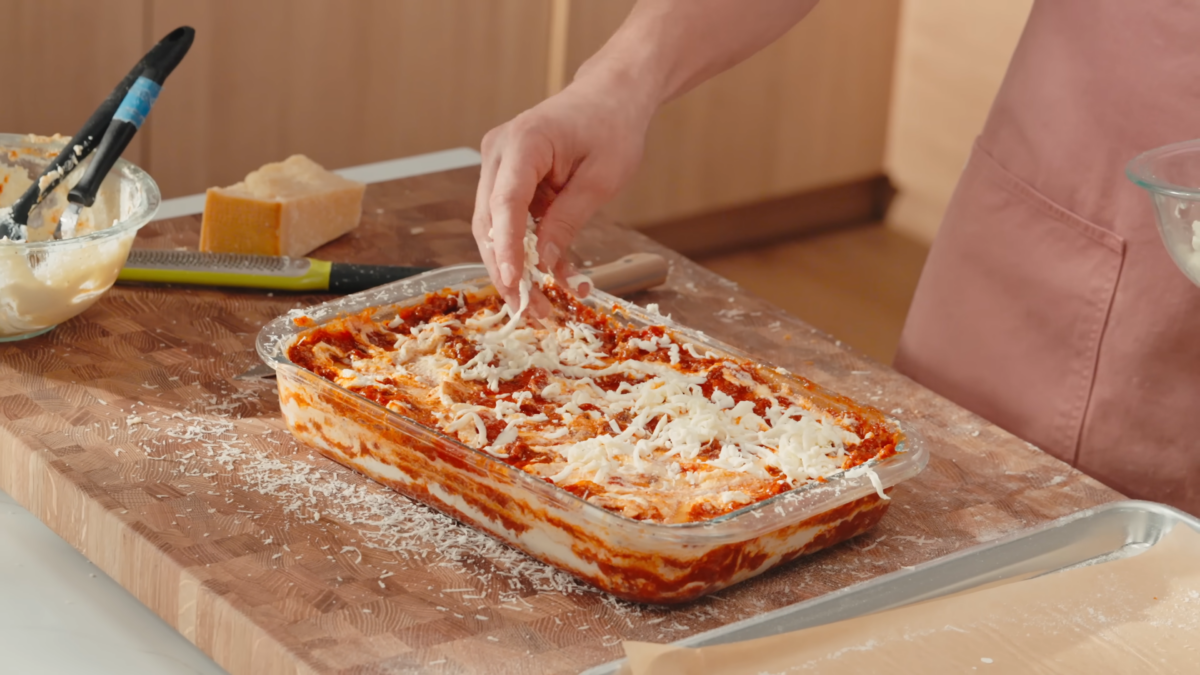
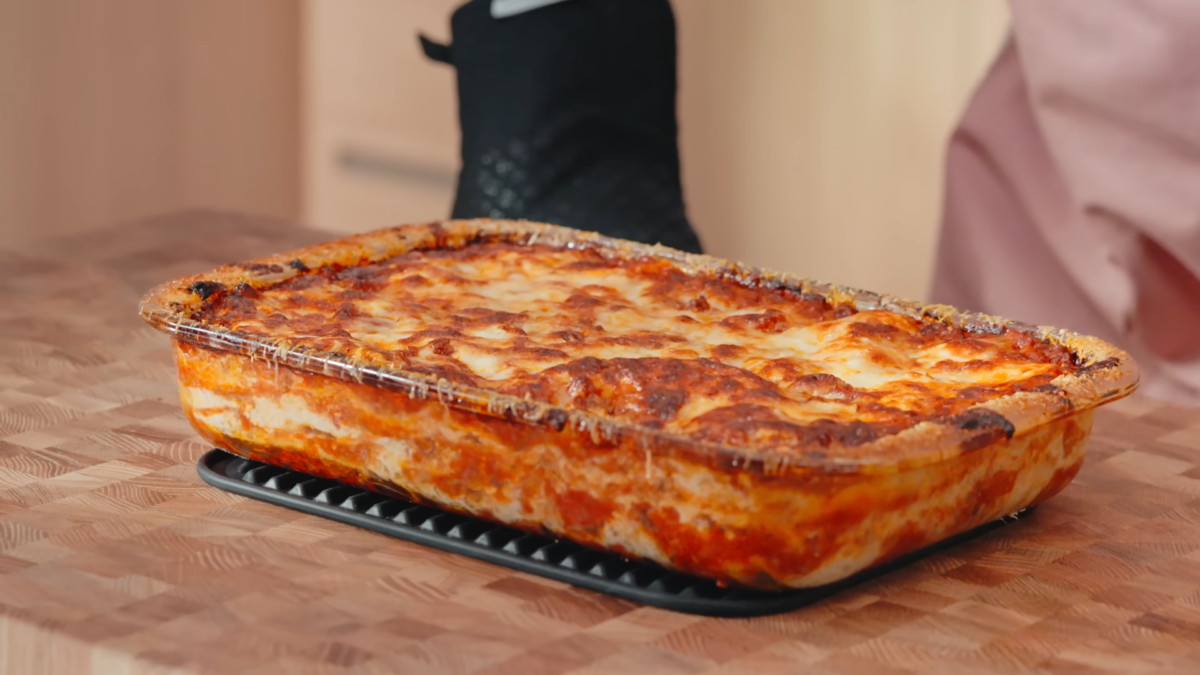
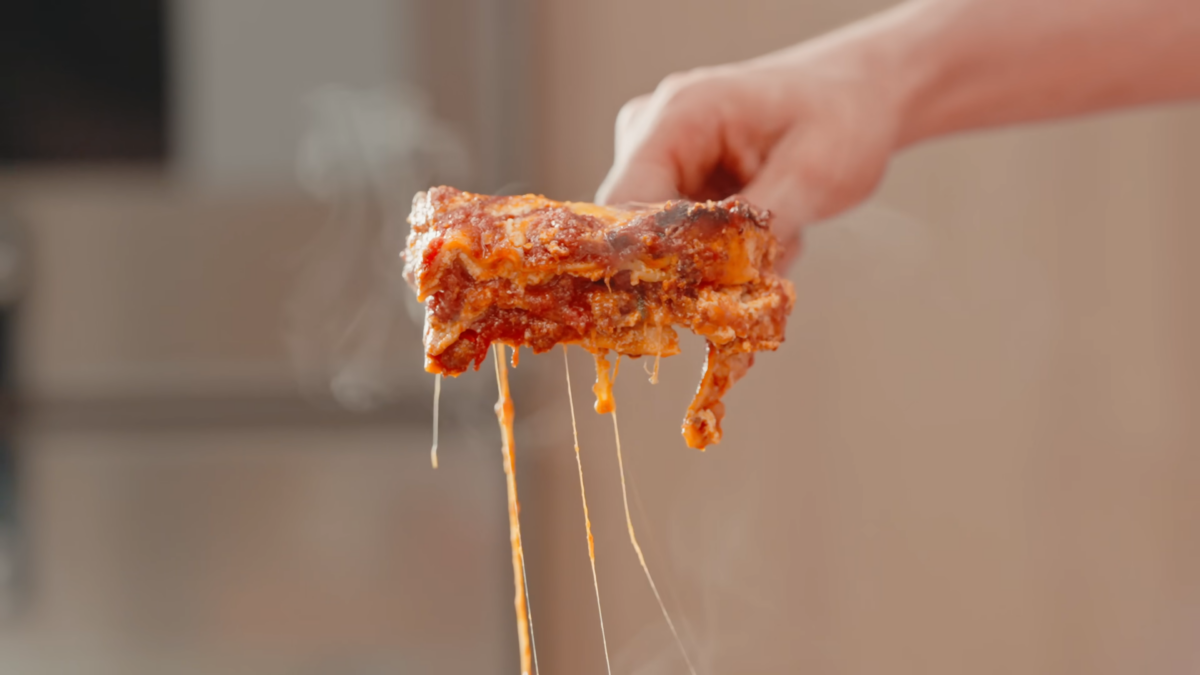
Nick’s Tips for Success
- Cover the pasta tightly. This prevents any air from reaching it, which can cause it to dry out and crack.
- Add water to the tomato can. I like to add ½ cup of water to my tomato cans and swirl it around to get any excess tomato product out and help thin the sauce a bit.
- Season as you go. Taste your sauce about halfway through cooking, and adjust the seasonings, if needed. Then, give your ricotta mixture a quick taste test, and adjust the flavor before adding the raw egg. I usually like mine extra salty.
- Overlap when layering. This ensures that all the layers hold together. I even often cut sheets of remaining noodles to fill in any cracks.
- Layer evenly. A common mistake I see is adding too much sauce to the center of the baking dish, which can cause your lasagna to be a little lopsided or even soggy. To avoid this, spread it out thinly and make sure it reaches all the way to the corners. Then, continue to spread all the layers evenly all the way to the edge of the pan. I often use an offset spatula for the ricotta layers to make sure everything is nice and smooth.
- Use a sheet tray. I always place my casserole dish on a sheet tray before baking to catch any spills that bubble up from the pan and keep my oven clean.
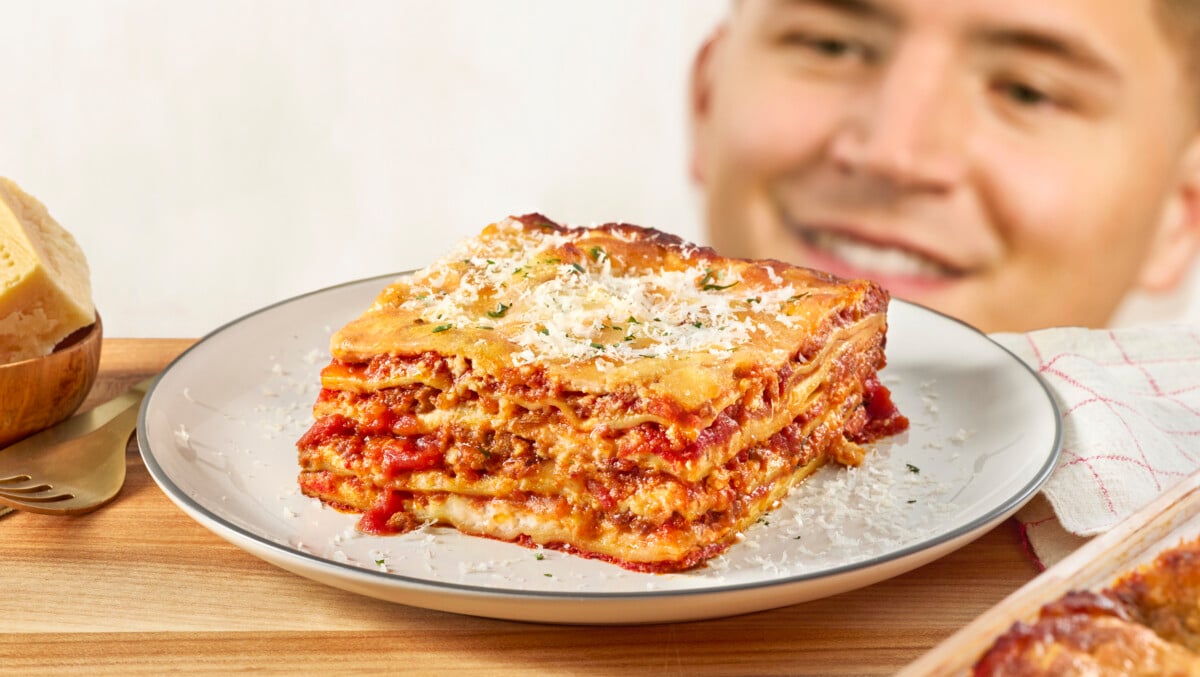
Classic Lasagna Recipe
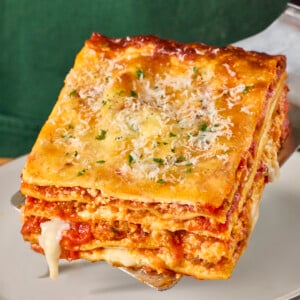
Equipment
- 1 Dutch Oven
- 1 Stand Mixer
- 1 Medium Mixing Bowl
- 1 (9×13 inch or 23×33 centimeter) casserole dish
- 1 Sheet Tray
Ingredients
For the Red Sauce
- 2 tablespoon (28 gram) olive oil
- ½ pound (225 gram) hot Italian sausage
- ½ pound (225 gram) sweet Italian sausage
- 1 small (150 gram) yellow onion, finely chopped
- 5 large (25 gram) garlic clove, finely chopped
- 1 teaspoon (2 gram) fennel seeds, crushed
- ¼ teaspoon (1 gram) crushed red pepper flakes
- 1 (4.5 ounce / 130 gram) tube double concentrate tomato paste
- 2 (28 ounce / 794 gram) cans whole peeled tomatoes
- ½ (20 gram) small bunch basil, chopped
- kosher salt and black pepper, to taste
- sugar, as needed
For the Fresh Pasta
- 2 cup (300 gram) 00 flour
- 2 large egg
- 7 egg yolk
For the Ricotta Filling
- 1 (32 ounce / 907 gram) container whole milk ricotta
- 3 (10 gram) garlic clove, minced
- 2 large egg, well beaten
- ⅓ cup (40 gram) Parmesan cheese, freshly grated
- ¼ teaspoon (1 gram) nutmeg, freshly grated
- kosher salt and black pepper, to taste
For Assembly
- 1 pound (453 gram) whole milk mozzarella, shredded
- ½ cup (40 gram) Parmesan cheese, freshly grated
Instructions
For the Red Sauce
- In a Dutch oven over medium high heat, add the olive oil. While the oil is heating, remove the sausage from its casing.2 tablespoon olive oil, ½ pound hot Italian sausage, ½ pound sweet Italian sausage
- Once the oil is shimmering, add the sausage to the pot and break it up into small pieces using a wooden spoon. Cook the sausage for six to eight minutes, or until golden brown.
- Reduce the heat to medium, then add the onion and stir to incorporate. Cook for four to five minutes, or until the onion is mostly softened. Then add the garlic, fennel, and crushed red pepper. Cook for one to two minutes, stirring often, or until the aromatics are fragrant. Add the tomato paste, and stir it to incorporate it into the sausage mixture. Cook for three to four minutes, stirring constantly and scraping the bottom to prevent burning.1 small yellow onion, 5 large garlic clove, 1 teaspoon fennel seeds, ¼ teaspoon crushed red pepper flakes, 1 tube double concentrate tomato paste
- Once the tomato paste has turned a darker red color, add the tomatoes, squeezing them into the Dutch oven as you add them. Add half cup (118 milliliter) of water to the tomato cans and swirl to get any excess tomato product out of the can, then add the water to the pot. Stir to combine everything, then add the basil and season with salt and pepper. Taste and add sugar if the sauce is too acidic.2 cans whole peeled tomatoes, ½ small bunch basil, kosher salt and black pepper, sugar
- Bring the sauce to a simmer and cook, uncovered, for one hour, stirring occasionally. Taste halfway through and season with additional salt, pepper, and sugar, if needed.
- Once the sauce has reduced by 25%, remove the pot from the heat and cover until ready to assemble. When assembling, the sauce should be warm.
For the Fresh Pasta
- Add the flour to a clean work surface. Create a well in the middle and add the eggs, egg yolks, and salt into the center. Using a fork, whisk the eggs and salt together, pulling in small amounts of flour as you go. Continue this process until a thick egg paste forms. Then pull in more flour, combining more and more as you go. Once you can no longer combine using the fork, switch to your hands and slowly knead the dough together.2 cup 00 flour, 2 large egg, 7 egg yolk
- Once all of the flour is incorporated into the dough, knead the dough for about ten minutes, or until the surface is smooth and elastic.
- Wrap the dough in plastic wrap and leave at room temperature to rest for one hour. Once the dough is fully rested, it should spring back slowly when pressed with your finger and be darker in color.
- Unwrap the dough and divide it into four equal portions (121 gram / 4 ounce). Then, working with one portion at a time, press the dough piece into a rough rectangle. Cover the remaining portions with plastic wrap so they do not dry out.
- Attach a pasta roller attachment to a stand mixer and set it to 0, or the widest setting. Pass the shortest end of the dough through the roller twice.
- Transfer the pasta to a clean work surface and fold one of the short ends of the dough into the center. Do the same with the other side, completing a tri-fold. The longest side of the envelope should be five inches (13 centimeters=) in width.
- Pass the dough through the widest setting, leading with the five-inch (13 centimeters) wide side.
- Repeat this process through the widest setting two times, passing through three times in total.
- Adjust the dial of the pasta attachment to the next setting and pass the dough through three times. Repeat this process until the dough is 1/8 inch (3 millimeters) thick or on the sixth setting.
- Line a sheet tray with parchment.
- Trim the ends of the pasta sheet to square off the sheet. Then cut the finished pasta sheet into 7 ½ inch (19 centimeter) long pieces, keeping any trimmings or shorter pieces to the side.
- Add the sheets of pasta to the sheet tray, and top with parchment.
- Repeat the dough rolling process with the additional dough balls. Set aside until you are ready to assemble.
For the Ricotta Filling
- Add all of the ingredients to a medium mixing bowl and whisk to combine. Cover and refrigerate. Remove the mixture one hour before you begin assembling. It is much easier to spread if it is not right out of the refrigerator.1 container whole milk ricotta, 3 garlic clove, 2 large egg, ⅓ cup Parmesan cheese, ¼ teaspoon nutmeg, kosher salt and black pepper
For Assembly
- Preheat the oven to 400°F (204°C).
- Add just enough of the red sauce to the bottom of a 9×13-inch (23×33 centimeters) casserole dish. Spread it into an even, thin layer. Add three pasta sheets vertically and slightly overlapping each other.
- Spoon ¼ of the ricotta mixture on top of the pasta sheets. Using an offset spatula or the back of a spoon, gently push the ricotta to the edges of the pasta. Sprinkle the mozzarella onto the ricotta, add one tablespoon of Parmesan, then spoon ¼ of the red sauce over the top.1 pound whole milk mozzarella, ½ cup Parmesan cheese
- Top the sauce with more fresh pasta, lightly pressing the sheets into the sauce to create a somewhat flat surface.
- Repeat the process until all of the pasta is used, then add the remaining red sauce onto the pasta, followed by the remaining ricotta. Add the rest of the mozzarella over the top, allowing some pockets of sauce to peek through. Sprinkle Parmesan cheese around the edges, and a bit throughout the middle.
- Place the casserole dish on a sheet tray.
- Bake for 45-60 minutes, or until the top is bubbly and golden brown.
- Remove it from the oven and allow it to cool for 30 minutes.
- Slice and serve.
Video

Notes
– Store leftovers covered or transferred to an airtight container in the refrigerator for up to three to five days.
– Freeze baked or unbaked lasagna for up to three months before baking. To serve unbaked lasagna, thaw it in the fridge overnight. Then, bake as normal, adding more time as needed for the layers to cook through.
Nutrition
Nutrition information is automatically calculated, so should only be used as an approximation.
 Like this recipe? Rate & comment below!
Like this recipe? Rate & comment below!Frequently Asked Questions
Yes, you can layer all the ingredients and refrigerate them for up to two days before baking. Alternatively, freeze baked or unbaked lasagna for up to three months before baking.
To serve unbaked lasagna, thaw it in the fridge overnight. Then, bake as normal, adding more time as needed for the layers to cook through.
Warm leftovers in the microwave or covered in the oven at 350°F (177°C) until heated through.
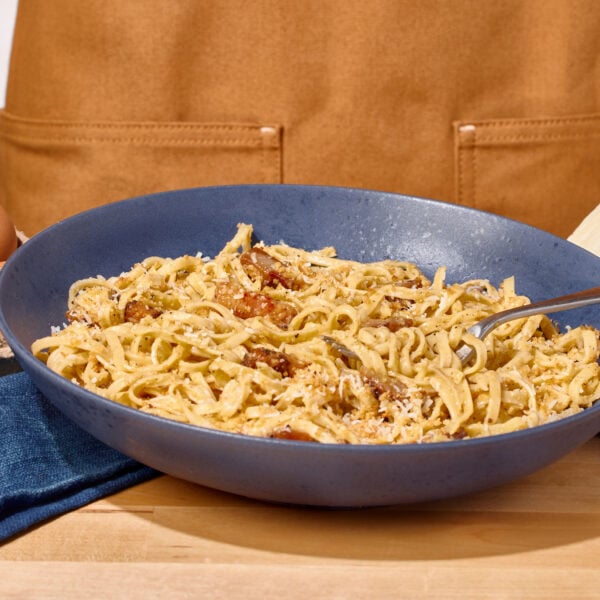
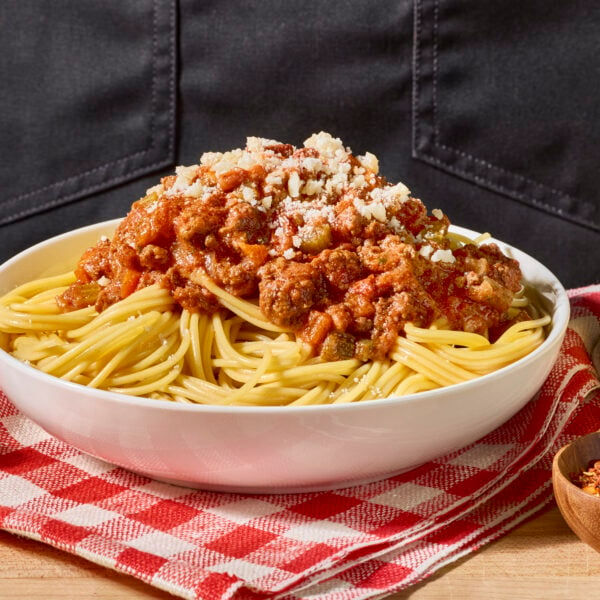

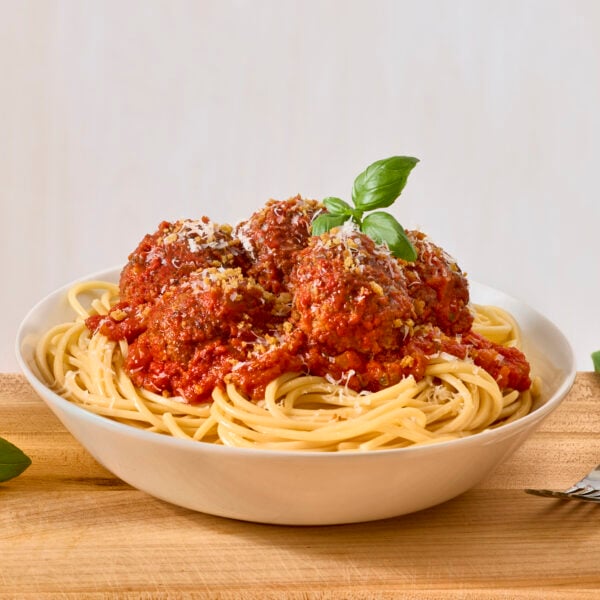
Great recipe, but if we cannot get seasoned sausages, and we can only use mince, what spices should we add to make up for the lost seasoning in the sausages?
Common seasonings in sausage include salt, pepper, garlic, onion powder, fennel, sage, and paprika. I hope you enjoy the recipe!
Do we have to cover the baking dish with aluminum foil?
Or can we bake without it. What will be the difference?
Bake the lasagna uncovered unless it begins to brown too quickly. If you notice early browning, cover the dish with foil until the lasagna is heated through. Then, uncover at the very end of baking. Hope this helps!
Absolutely amazing
I love lasagne and if is sooo nice